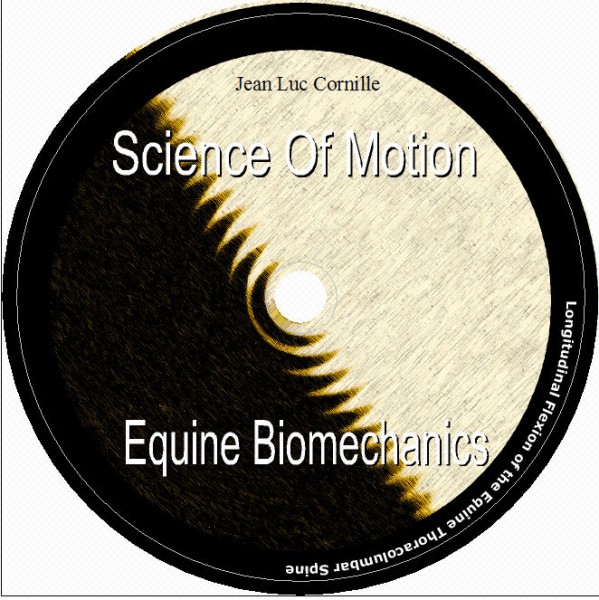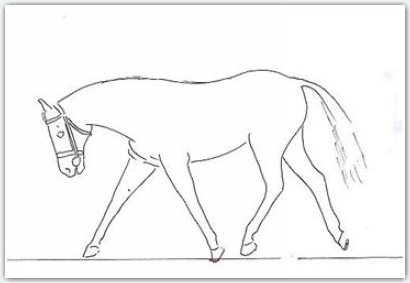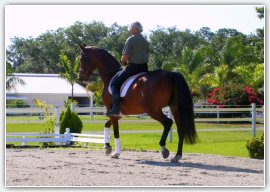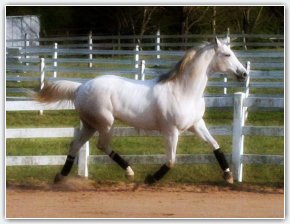| Upcoming JLC Clinics
Feb 16th & 17th
Jean Luc Cornille Clinic
370 Crooked Creek Road
Eatonton, GA 31024
call or email Helyn for information 706-485-1217 email helyn@scienceofmotion.com
|
|
Greetings!
We hope everyone had a wonderful Christmas and a Happy New Year!
We have added two new DVD/Videos which are must have for the serious equestrian. Plus we have lowered costs of all of our Books. Please visit our Shop page HERE. On our horse training program at our farm we have one opening till March.Information on horse training HERE If you are interested in hosting a clinic check HERE for complete information. Sincerely,
Editor Helyn Cornille
Science Of Motion |
|
New DVD/Videos
Science Of Motion
We have added two new DVD's.
FORWARD Part 1
 | | Forward Part 1 |
You have been told that the hind leg propels the horse's body upward and forward as soon as ground contact. This is not accurate. The alighting hind leg produces first a decelerating action resisting attraction of gravity and inertia forces. In fact, the forelegs produce more upward propulsive forces than the hind legs.
"In horses, and most other mammalian quadrupeds, 57% of the vertical impulse is applied through the thoracic limbs, and only 43% through the hind limbs." (H. W. Merkens, H. C. Schamhardt,G. J. van Osch, A. J. van den Bogert, 1993). The video Forward shows the decelerating and propulsive activity of the hind and front legs and explains how these discoveries modify our perception of balance and how we can educate the horse to achieve balance control.

$30. Plus shipping
Equine Biomechanics
 | | Equine Biomechanics |
"After a certain high level of technical skill is achieved, science and art tend to coalesce in esthetics, plasticity, and form. The greatest scientists are always artists as well." (Albert Einstein)
Equestrian education is summarized under the form of principles and formulas. While for many, doctrines and clich�s are what riding is about, the truth is that principles and formulas are only canvas supporting a real art. Rhythm, feeling, skill, emotions, extensive knowledge of equine biomechanics, are part of the equation. Anyone can teach principles and formulas but with such teaching, students never go beyond studious application of correct aids. It demands a lot more knowledge and artistic views to create a good rider. "Equine Biomechanics" explains how the horse achieves balance control and true forward movement through a unique combination of science, art and humor.

$50. plus shipping
|
|
Reflections on the Rollkur
VIdeo/Jean Luc Cornille
Use the PAUSE button to read!
 | | Reflections on the Rollkur |
|
Lowering of the neck and consequent
increased load on the foreleg
Jean Luc Cornille
As you know, sometime I look in Jean Luc work picking up paragraphs that I think are interesting. This is part of a study that is going to be part of our IHTC's January installment. It is a very interesting study analyzing from the kinematics of the hind and front legs all the way to the work of the back and upper neck muscles, how the horse's body deals with the lowering of the neck and consequent increased load on the forelegs.
This is the silhouette of a horse working long and low.  This is not an exaggeration. This is the exact copy of a picture extracted from a video promoting the lowering of the neck. The author sees a horse reaching with the neck and swinging the back. This opinion is far removed from reality. If we analyze the horse locomotor mechanism from the alighting hind leg to the muscles involve in the lowering of the neck, we see a totally different picture. In fact a very damaging picture will surface. We start here with the kinematics of the alighting hind leg. This is not an exaggeration. This is the exact copy of a picture extracted from a video promoting the lowering of the neck. The author sees a horse reaching with the neck and swinging the back. This opinion is far removed from reality. If we analyze the horse locomotor mechanism from the alighting hind leg to the muscles involve in the lowering of the neck, we see a totally different picture. In fact a very damaging picture will surface. We start here with the kinematics of the alighting hind leg.
The horse is at the trot going into the fly period before landing on the right diagonal, (left hind leg and right foreleg). The left front leg is still carrying a lot of weight, which is not surprising considering the orientation of the horse's body. The horse is heavily on the forehand and consequently the horse has to adapt the kinematics of the hind and front legs to such imbalance on the forelegs. For comparison, we place the picture of a horse working at a normal balance.
 | | Normal Balance |
At this sequence of the stride, unless damaged by inappropriate training technique, the left foreleg should be off the ground and into the swing phase. Under normal circumstances, the forelegs produce more upward vertical force than the hind legs. The forelegs produce 57% of the vertical impulse while the hind legs produce only 43%. The horse picture on this silhouette carries too much weight on the front legs to be able to properly use the upward propulsive activity of the forelegs. The kinematic adaptation to excessive weight is inducing abnormal stresses on the whole front limb structure from the bones and joints to the soft tissues. We will analyze later in this discussion, the kinematics abnormalities of the forelegs and their consequent damages on the joints, tendons and ligaments. Considering the forward movement of the body and the position of the left hind leg shortly before impact, one can objectively conclude that the impact of the left hind leg will occur only slightly ahead of the vertical of the stifle, which is no engagement at all. Without any constraint, a horse engages naturally the hind legs more forward than the horse working with a low neck posture. (On the IHTC document, this sequence is demonstrated with a horse working at the lunge line with a low neck posture. The video commences at exactly the same sequence and frame by frame, shows where the hind leg touches the ground). Due to this early impact, the supporting hind legs is not going to be capable to decelerate the horse's body during the first half of the stance. From impact and until 45% of the support phase, which is referred to as the stance, the supporting hind leg decelerates the horse's body resisting gravity and inertia forces. This sequence of the stride is named the braking phase. A better terminology is "decelerating" phase. During this decelerating phase, the joints and associated muscles and ligaments absorb as well as resist gravity and inertia forces, accumulating elastic strain energy that is immediately used in the following pushing and swing phase. Balance control is created increasing the duration of the time the supporting hind leg remains on the ground. "It should be borne in mind that the weight of the rider will raise two- or three-fold during locomotion and also that more energy is required by a mounted horse and this energy must be obtained by increasing the stance phase so as to recover more energy during the swing." (J. L. Morales, DVM, PhD, 1998)  On the silhouette of the horse working with a low neck posture, the alighting of the hind leg occurs too far back altering the horse's capacity to resist attraction of gravity and inertia force and therefore, the hind leg capacity to control balance during the decelerating phase. The kinematics of the alighting hind leg also handicaps the horse ability to store elastic strain energy for the following swing phase. Early impact of the hind leg creates the situation of a functional straight hock, which induces the same stresses on the hock joint than a morphologic straight hock. According to James Rooney such kinematics abnormality induces stress on the hock joint between Mt3 and T3. "This shortened stride causes a functional straightleg and arthrosis of Mt3-T3. And the study goes on all the way to the neck. The first sentence about the neck is an interesting fact. Lower neck muscles don't have the strength to elongate the upper neck muscles. For a great part, the lowering of the neck is created by gravity. The head and neck weight 10% of the horse's body weight and the work of the upper neck muscles is to resist attraction of gravity that is pulling the neck down to the ground. As the neck lowers, he upper neck muscles do not reach or stretch but instead resist attraction of gravity. Jean Luc Cornille Link to article on website
|
|
Science Of Motion/Jean Luc Cornille
Equine Training at our farm
nstead of sending your horse to be crippled at Wellington or Ocala, use the winter to upgrade your horse at the next level, resolve problems hampering the horse's performances, or restore soundness.
Only two horses at the time. Training is a demanding business. There is the time spent on the horse's back for gymnastic and the time spent with the horse. Nurturing is part of the education. A horse properly trained is asked to think and challenge his physique. The horse needs to feel special and confident. Such is our strong belief and the reason why, when Jean Luc's clinic program become extremely busy, we placed the training program in standby. We knew that we will not have the time to do it properly. With the winter, the clinics in the North are slowing down allowing saving the week days for the horses. Clinics are now on weekends allowing us to keep horses in training year round. With a training program focusing on the root cause of the horse's difficulties, progresses are rapid and beyond the scope of conventional approaches. Distance and occupation permitting, we are encouraging the rider to closely follow the horse's progresses. We have the capacity to host comfortably both, the horse and the rider (guest house). Guest house (if available) limited to 3 days cost of $60. day. Overseas guest option of longer stay. In average, the horse is trained 5 days per week. The training occurs from early morning to early afternoon. As much as possible, the same horse works at the same hour every day. Regularity is the trademark of our training program. Feeding schedule, turn out, special cares, are all part of a routine that the horse knows and is comfortable with. Due to the limited number of availabilities, we encourage you to contact us rapidly for scheduling. Monthly fee of $2800. includes riders education. (last few days of training can be done with rider)A deposit of $1000. upon reservation. Balance due on arrival with coggins and vaccination papers. Contact us at 706-485-1217
|
|
About Jean Luc Cornille
Qualibet Z with Jean-Luc Cornille
at the World Eventing Championships in Punchestown
(Rantzon in 1971 became ranked 5th best sire of eventers thanks to Quolibet Z and Uric F.)
Jean Luc's competitive career is as distinguished as it is diversified. Competing at national and international levels in dressage, steeplechase, stadium jumping and three-day events, he has won extensively in all specialties collecting several gold, silver and bronze medals. Notably, Jean Luc won the individual and team gold medal at the military world championship of Fontainebleau in 1975. In 1971, he won silver at the world championship of Punchestown. The following year, he was member of the winning team at Bokello. However, Jean Luc feels that his greatest success lies in his ability to intuit the physical and mental condition of each horse the day after their victories.
A 1968 graduate of the Equestrian Military School, Le Cadre Noir de Saumur, Jean Luc received intensive training from Joseph Neckerman, Willy Schulteis and Hans Gunter Winkler. In 1972 and 1976, respectively, he worked closely with Michel Cochenet to prepare two Olympic teams for the national three-day event. Margit Otto Crepin, the French and Olympic Champion, is one of Jean Luc's most prominent dressage students.
|
|